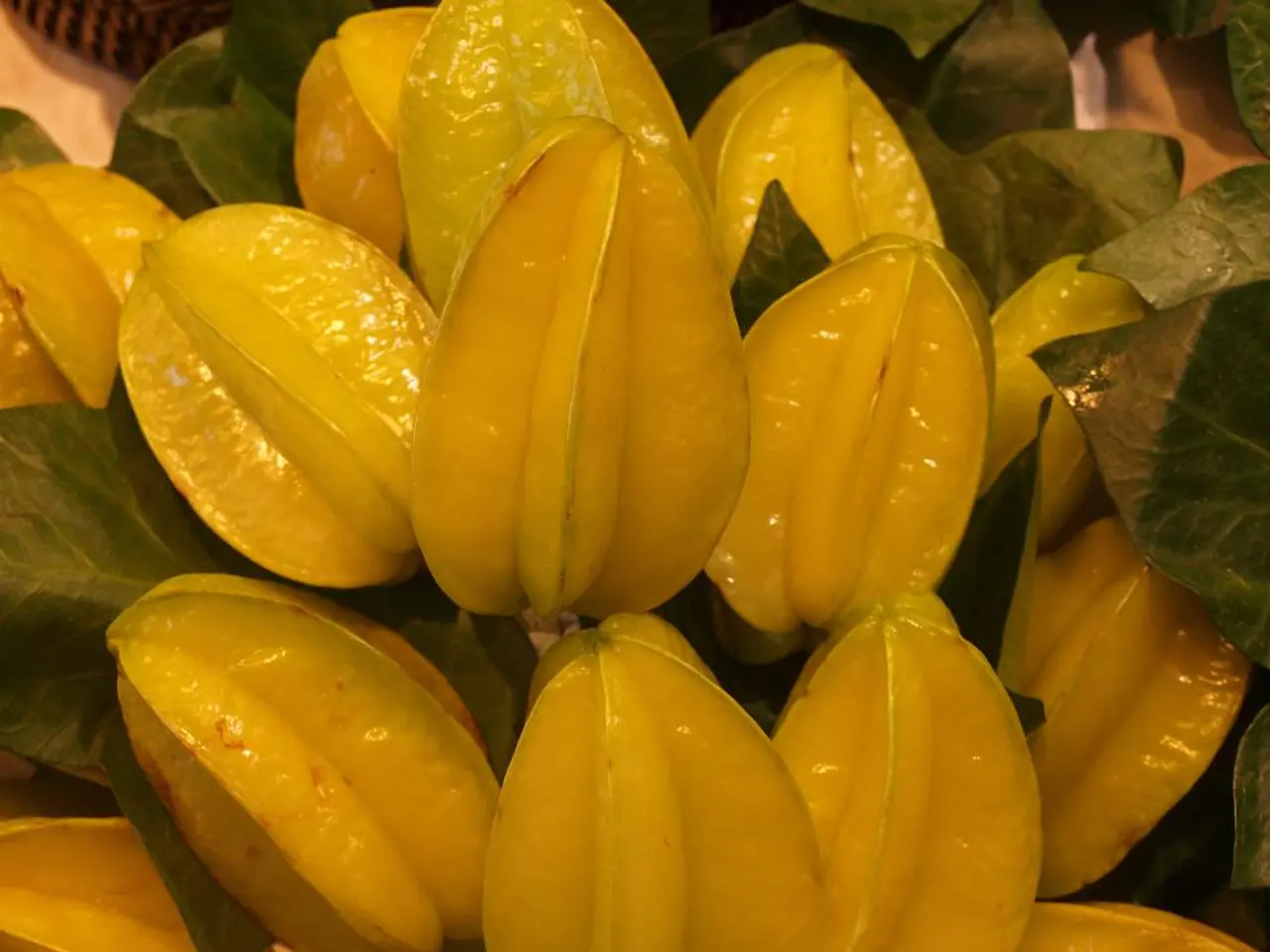Star Fruit's Nutritional Advantages, Composition, and Enjoyable Consumption Methods
The star fruit, with its distinctive star shape and crunchy, juicy texture, is a popular tropical fruit enjoyed in many parts of the world. But, like any food, it comes with its own set of health considerations.
Star fruit is rich in fiber, containing around 27% hemicellulose and 13% pectin. It's also a source of antioxidants, beta carotene, and vitamin C. The high amount of fiber in star fruit can help balance blood sugar levels.
Ripe star fruit can be added to salads, juices, smoothies, used as a garnish, or made into star fruit syrup for desserts. However, unripe star fruit has higher oxalate levels and can cause an upset stomach or vomiting.
The common health risks associated with consuming large amounts of star fruit primarily stem from its content of oxalic acid and a neurotoxin called caramboxin. For most healthy individuals, consuming star fruit in typical amounts is generally safe, as their kidneys effectively filter these substances.
However, for individuals with impaired kidney function, including those with chronic kidney disease or kidney failure, even small amounts of star fruit or its juice can lead to severe toxicity. Their kidneys cannot effectively remove oxalic acid and caramboxin, leading to a rapid build-up of these toxins. This can result in symptoms such as nausea, vomiting, abdominal pain, persistent hiccups, mental confusion, muscle weakness, numbness, seizures, coma, and in extreme cases, death. Medical intervention like dialysis might be required to remove the toxins.
Additionally, star fruit toxicity has been associated with neurological symptoms resembling stroke or serious neurological events due to the neurotoxic effects of caramboxin.
In summary, the most common health risks of consuming large amounts of star fruit are:
- Oxalate nephropathy and kidney damage (especially in people with kidney impairment)
- Neurotoxicity leading to confusion, seizures, coma
- Gastrointestinal symptoms: nausea, vomiting, abdominal pain, persistent hiccups
Healthy individuals would need to consume unusually large amounts to face these risks, but those with any kidney issues should avoid consuming star fruit or its juice.
A medium-sized star fruit contains approximately 121 milligrams of potassium, 31.3 milligrams of vitamin C, 10.9 milligrams of phosphorous, 9.1 milligrams of magnesium, 2.73 milligrams of calcium, and 1.8 milligrams of sodium. A medium-sized star fruit contains approximately 28 calories, 6.1 grams of carbohydrates, 1 gram of protein, and 2.5 grams of fiber. The skin of a star fruit is waxy, yellow or green, and edible.
To prepare star fruit for consumption, rinse it under running water, cut it into thin slices, discard the seeds, and ensure the fruit is ripe (bright yellow with minimal green areas).
In many Asian countries and Brazil, star fruit is used as a traditional treatment for various ailments such as fever, sore throat, cough, asthma, headaches, and skin problems. However, it's important to note that more research is needed to confirm these potential health benefits.
Star fruit can interact with medication, slowing down the body's clearance of drugs and potentially leading to higher levels of these drugs in the body. Therefore, it's always a good idea to consult with a healthcare provider before incorporating star fruit into your diet, especially if you are taking medication.
[1] National Kidney Foundation. (2021). Star Fruit: What You Need to Know. Retrieved from https://www.kidney.org/atoz/content/starfruit [2] Mayo Clinic. (2021). Star fruit: Nutrition facts and health benefits. Retrieved from https://www.mayoclinic.org/foods/star-fruit/nutrition-charts/row/20146843 [3] ToxNet. (2021). Caramboxin. Retrieved from https://toxnet.nlm.nih.gov/cgi-bin/sis/search/a?dbs+hsdb:@term+@DOCID+1480 [4] Food and Drug Administration. (2021). Star fruit. Retrieved from https://www.fda.gov/food/buy-store-serve-safe-food/star-fruit [5] National Institutes of Health. (2021). Toxicology Data Network. Retrieved from https://toxnet.nlm.nih.gov/cgi-bin/sis/search/a?dbs+hsdb:@term+@DOCID+24951187
- The fiber in star fruit has a significant role in managing blood sugar levels, making it a valuable addition in the health-and-wellness sector.
- In addition to fiber, star fruit boasts a rich compendium of antioxidants, beta carotene, and vitamin C, contributing to overall eye-health and skin-care.
- Fitness-and-exercise enthusiasts may appreciate star fruit's low-calorie content, with a medium-sized fruit providing approximately 28 calories.
- For individuals following a specific nutrition plan, a medium-sized star fruit supplies approximately 121 milligrams of potassium and 31.3 milligrams of vitamin C.
- Skin-care benefits are claimed for star fruit by some communities, making it an attractive ingredient in therapies-and-treatments.
- Incorporating star fruit into family-health discussions could involve educating about its varied uses in salads, juices, and desserts, as well as potential risks associated with unripe or large amounts.
- In terms of mental-health, consumers should be aware of the interactions between star fruit and medication, which may necessitate adjustments in dosage or cautious consumption.
- Greater exploration is needed to confirm the asserted benefits of star fruit for managing medical-conditions like fever, sore throat, and certain skin-conditions such as psoriasis.
- Parents may find it crucial to probe the safety of star fruit for kids with chronic-diseases like chronic-kidney-disease or kidney failure, due to the links between large consumption and severe toxicity.
- Given the toxins present in star fruit, those considering an outdoor-living lifestyle in tropical regions should be aware of potential health risks posed by the fruit.
- Extensive global-cuisines have embraced the versatile star fruit, finding a place in food-and-drink traditions from Asian countries to Brazil.
- One could argue that star fruit is an attractive choice for clean-eating dining experiences due to its natural, non-processed constituents.
- The popularity of sustainable-living has brought into focus the advantages of choosing seasonal fruits like star fruit in one's home-and-garden, promoting a healthier lifestyle.
- Engaging in home-improvement projects can be an opportune time to investigate beverages and recipes incorporating this exotic fruit.
- From sweet star fruit syrup to unique recipes showcasing global-cuisines, cooking becomes an adventure with star fruit as an ingredient.
- For home chefs experimenting with baking, star fruit can introduce an exciting contrasting texture and taste in beverages and desserts.
- Dining establishments may capitalize on the unique flavor and attractive appearance of star fruit, offering both fresh fruit and star fruit-infused dishes.
- Those with kidney problems may wish to consult product-reviews before choosing electric-vehicles that utilize the star fruit in their interior-design for potential toxicity concerns.
- With many different types of cars available, it's important to consider car-maintenance essentials such as washable seat covers for when messy foods like star fruit become an unavoidable part of road trips.
- Budget-conscious travelers seeking adventure-travel could take advantage of cultural-travel opportunities that involve traditional star fruit ecosystems while remaining aware of potential health risks.
- Culinary tourists might find it fascinating to try local star fruit dishes in various global destinations, while also learning about the role the fruit plays in traditional health practices.
- To make informed decisions surrounding star fruit purchases, consumers can turn to reliable reviews and resources related to product-reviews, health benefits, and potential risks found on reputable websites such as National Kidney Foundation, Mayo Clinic, ToxNet, Food and Drug Administration, and National Institutes of Health.




